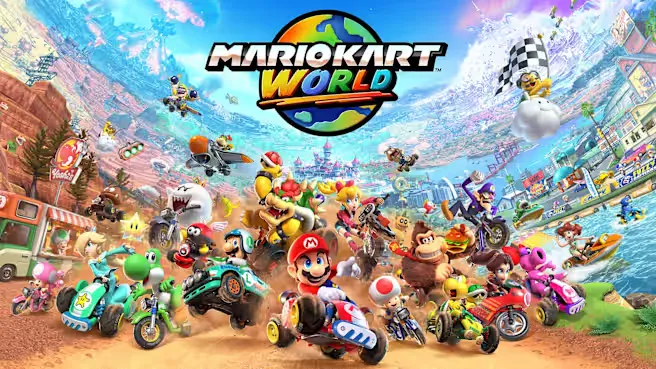Nintendo's newest racer is a chaotic, marvelous time. It's a bold, refreshing new take on the Mario Kart franchise, but it's not without its (minor) flaws.

Could Nintendo have had higher expectations for this game? Mario Kart is a treasured franchise to nearly every Nintendo customer; it’s been a staple of the Nintendo experience since 1992 released for the SNES. My first entry as a child was Double Dash on the GameCube, and I’ve made a point to play countless hours of each release since. So as the company began to show off its newest console, the Nintendo Switch 2, and it announced Mario Kart World as its only first-party launch title (no, Welcome Tour does not count, nor do the “Switch 2” editions of older games), high expectations were unavoidable.
As an aside, the Nintendo Switch 2 is a delightful hardware upgrade for the Switch. Even games without dedicated patches are notably better to play due to the drastically shortened load times. And the console itself feels decidedly premium in comparison to the original, boasting a larger screen and a matte finish on the plastic casing that feels much nicer in the hand.
Nintendo, as it nearly always does, delivered a game that not only exceeded those lofty expectations but simultaneously delivered frustration and disappointment to a non-negligible portion of its audience. How could that be true? Let’s dive in, starting with everything to love about this game.
The Highlights
The most notable, and obvious, differentiator to Mario Kart World from the rest of the franchise is its massive open world that you’re free to explore at any time using the “Free Roam” mode. Neatly tucked into every corner of the map, you’ll come across all of the distinct courses that the game features in its “Grand Prix” mode, but you’ll also find a huge number of P-switches (which activate micro-challenges to complete), and two different collectibles to gather. Free roam is decidedly not the most exciting part of the game — it can feel empty at times — but it is a relaxing, entertaining way to engross yourself into the visually stunning and varied world Nintendo has crafted (all while listening to the expertly composed and performed soundtrack).
Beyond Free Roam, the new mechanics of the game don’t disappoint. The new gimmick in this entry is the ability to ride on rails or even directly on the walls of a course, which enables some absolutely wild shortcuts for expert players, and a dynamic experience even for newcomers.
The classic “Grand Prix” mode is a bit different this go around, as after the first course, racers spend two-thirds of the next race traveling across the open world to the next course, which I’ve heard dubbed “intermission” races. These intermission races are an interesting change to the Mario Kart formula; opinions are mixed (more on that below), but I’m generally a fan. Nintendo mixes in a good amount of hazards into the travel, alongside the general increase in chaos from the now 24-player lobbies you’re pitted against (previous entries had 8 or 12 racers).
The standout new feature to me, though, is the new mode: Knockout Tour. In Knockout Tour, you travel across the open world with 24 other racers, crossing through several checkpoints along the way. At those checkpoints, the 4 last-place racers are knocked out, so there’s a constant pressure to keep yourself at the front of the pack, fighting against the onslaught of items from the pack behind you. It’s intense, and most importantly of all, it has no interruptions; it’s action-packed gameplay from start to finish without any loading screens for the next race.
The “Mario Party”-ification of Mario Kart
While I’d rate the open world design, including the use of those intermission tracks in the classic Grand Prix mode, as a refreshing change, online commentary hasn’t been so receptive. It takes little effort to find YouTube critiques, articles, social media rants, and so on bemoaning the change, citing that the game has become a “straight-line simulator.” Certainly, the core point levied in those complaints isn’t without merit; the straighter paths that each race now involves can be unexciting at times, even when they shine in the appropriate context (Knockout Tour). And Nintendo, unimpressed by these complaints, went out of their way to remove a workaround people had discovered to avoid the “intermission” tracks in online play, forcing even critics of the design to play the game as Nintendo wants, or to not play at all. It’s undeniably frustrating that Nintendo chooses to actively block obvious, small tweaks to their games (that could be optional settings, no less).
This isn’t a new development for Nintendo, though, and it’s unsurprising to me. Nintendo, in everything it does, has a very clear idea of how its games should be played, and they’ve made it clear now — if they hadn’t already in earlier entries — Mario Kart isn’t meant to be a competitive esport-style game. It’s meant to be a casual, chaotic game suitable for your friends and family. It’s that takeaway that’s led me to my conclusion: Mario Kart World aims to deliver an experience not unlike Mario Party games do: a casual competition where anyone, regardless of their skill, has a chance of winning.
As Eric Switzer, writing for TheGamer, so eloquently puts it:
The point of Mario Party is to try as hard as you can and then fail for no good reason. It’s a series that spits in the face of meritocracy and says, “Everything is made up and the rules don’t matter, but we can still have some fun amidst the chaos.” You can’t make Mario Party fair just like you can’t make life fair.
Why is that conclusion clear to me? There are three main contributing factors:
- The expansion to 24-player lobbies quite literally doubles the chaos that defines Mario Kart, and similarly, it significantly increases the likelihood that front-runners will fall victim to “getting Mario Karted”.
- Straight-line sections decrease the number of opportunities for practiced players to leverage shortcuts and mechanical know-how the people playing with them may not have.
- The rubber-banding that every Mario Kart game includes further enforces that players closer to last have mechanical advantages to bring them back into the race, and that even talented players face a challenge.
Mario Kart does not seek to always deliver an experience where the best player wins, and that’s not new to Mario Kart World. It aims to deliver an experience where you always have excitement. I’ve been frustrated by that too, at times, but it’s also the reason I can always easily convince my friends and family who don’t game consistently to play with me. That sense of community and shared fun is an invaluable part of what Mario Kart is to me, and Mario Kart World does an exceptional job of nurturing that.
